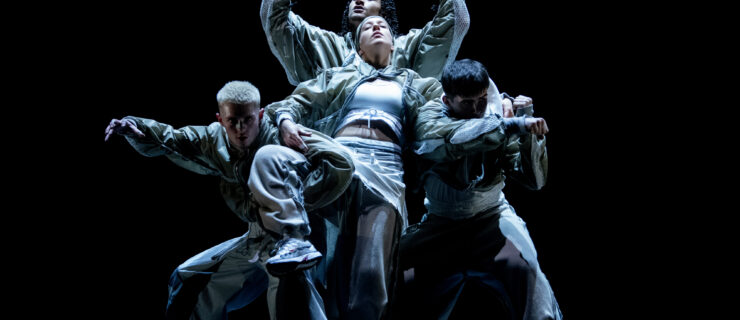Dana Tai Soon Burgess & Company
Dama Tai Soon Burgess & Company
A Project Moving Forward
Terrace Theater, John F. Kennedy Center For The Performing Arts
Washington, D.C.
November 5-7, 1999
Reviewed by George Jackson
Those who had seen Helix (1998) before and not scrutinized the playbill for this revised production were taken by surprise when the male soloist (choreographer Dana Tai Soon Burgess) passed behind John Dreyfuss’s bone-white sculpture and appeared on the other side transformed into a woman (supplely strong Sarah Craft). When (with Burgess’s reappearance) the sex-changed creature became a permanent male-female pair, there was general astonishment because Helix had been, and this time started out to be, a true solo that left a sense of aloneness in its wake. Despite the spiral entities to which this dance-sculpture piece alludes (a multitude of them, from molecular to galactic), the only thing human had been the moving body of the single dancer on view. What should be called Helix II becomes a true duo, for the two bodies give each other more than physical support. They are a comfort to one another in an expanding universe.
The dancing in both versions of Helix evolves from embryonic coilings and infant probings, through bipedal, to that which is about to launch into space. It fuses with Dreyfuss’s mobile sculpture (which resembles a fossilized fetus magnified, or the plaster cast of a giant’s ear), and with Jennifer Tipton’s planetarium lighting, Han Feng’s glamorous diaper costuming, and Christopher Nickels’s music of the spheres. Although the result refers to Graham/Noguchi collaborations, its stylistic coherence is distinct.
Gandhara: East West Passages
, by Burgess, Dreyfuss, Tipton, and Feng, with composer David Maddox plus scenario writer Mary Hall Surface, is even closer to Graham/Noguchi. There are specific characters (those in the life of Alexander the Great), a detailed narrative, a strong sexual drive and a sense of mission?all on a heroic scale. As contrast for his streamlining of “Graham Greek” dancing, Burgess coins a parallel stylization of elements from India’s traditions to portray Darius’s Persians. The work’s depiction of camaraderie and eros has pathos and finesse. Yet the story lacks a point of view?the sort Graham established by having a character stand apart from the action as witness. Dreyfuss’s sculpture?priapal when erect and a mountain ridge when lying flat?represents the attraction and separation between East and West. This whale of an object, though, couldn’t be manipulated as readily as it was intended.
As the third item in the Kennedy Center’s millennial Something New series, Gandhara was as good an idea as its predecessors?Suzanne Farrell’s 20th Century ballet stagings (see Dance Magazine, February, page 97) and Debbie Allen’s wonderful mess of a dance musical, Soul Possessed. While tidying up Soul might lessen its punch, Gandhara would profit from more work.




